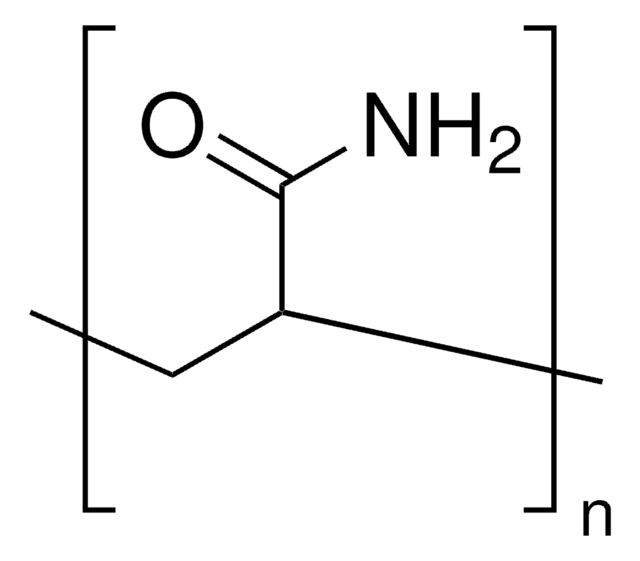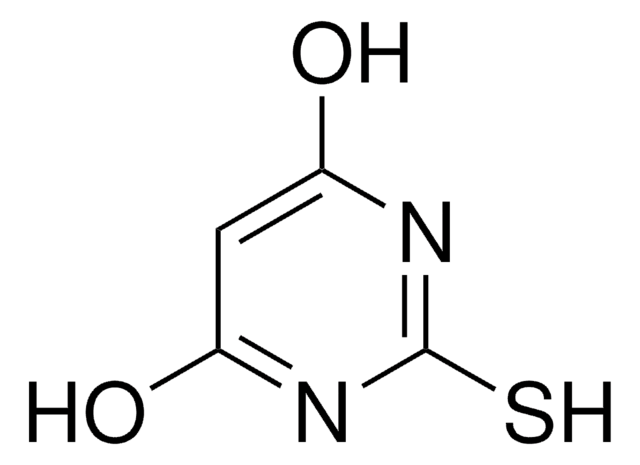Wichtige Dokumente
738743
Polyacrylamid
average Mn 40,000
Synonym(e):
PAM
About This Item
Empfohlene Produkte
Form
powder
Qualitätsniveau
Mol-Gew.
average Mn 40,000
mp (Schmelzpunkt)
246-250 °C
Übergangstemp.
Tm 246-250 °C
SMILES String
NC(=O)C=C
InChI
1S/C3H5NO/c1-2-3(4)5/h2H,1H2,(H2,4,5)
InChIKey
HRPVXLWXLXDGHG-UHFFFAOYSA-N
Suchen Sie nach ähnlichen Produkten? Aufrufen Leitfaden zum Produktvergleich
Verwandte Kategorien
Anwendung
- Proteomic analysis and lethality of the venom of Aegaeobuthus nigrocinctus, a scorpion of medical significance in the Middle East.: This study utilized polyacrylamide gel electrophoresis (PAGE) to analyze the protein composition of the venom, providing insights into its biochemical properties and potential medical applications. The results highlight the importance of PAGE in venom proteomics and its relevance in biomedical research (Borges et al., 2024).
- One-Dimensional Acrylamide Gel Electrophoresis for Analysis of Plant Samples.: This paper describes the methodology of using PAGE for the analysis of plant proteins, demonstrating its utility in biochemistry and molecular biology studies. The technique is essential for separating and identifying proteins in complex mixtures, underscoring its significance in research and development in the life sciences (Marzban et al., 2024).
- Protocol for isolating small cytosolic dsDNA from cultured murine cells.: The study outlines a detailed protocol incorporating PAGE for the isolation and analysis of small cytosolic dsDNA from murine cells. This method is pivotal for research in molecular and cellular biology, facilitating advancements in genetic and biomedical studies (Dai et al., 2024).
- Comparative study of the commonly used protein quantitation assays on different Hymenoptera venoms: A fundamental aspect of Hymenoptera venom proteome analysis.: This research compares various protein quantitation assays, including PAGE, to analyze Hymenoptera venoms. The findings underscore the critical role of PAGE in proteomic analysis and its application in toxinology and biomedical research (Wanandy et al., 2024).
- Proteomics and Its Current Application in Biomedical Area: Concise Review.: This review highlights the applications of proteomics, including PAGE, in biomedical research. It discusses the advancements and future directions in the field, emphasizing the importance of PAGE in proteomic studies and its contributions to biomedical science (Gobena et al., 2024).
Lagerklassenschlüssel
11 - Combustible Solids
WGK
WGK 2
Flammpunkt (°F)
Not applicable
Flammpunkt (°C)
Not applicable
Hier finden Sie alle aktuellen Versionen:
Besitzen Sie dieses Produkt bereits?
In der Dokumentenbibliothek finden Sie die Dokumentation zu den Produkten, die Sie kürzlich erworben haben.
Kunden haben sich ebenfalls angesehen
Artikel
Highlighting existing and novel fabrication methods for both, solid and hydrogel-based scaffold for tissue engineering applications.
Unser Team von Wissenschaftlern verfügt über Erfahrung in allen Forschungsbereichen einschließlich Life Science, Materialwissenschaften, chemischer Synthese, Chromatographie, Analytik und vielen mehr..
Setzen Sie sich mit dem technischen Dienst in Verbindung.






